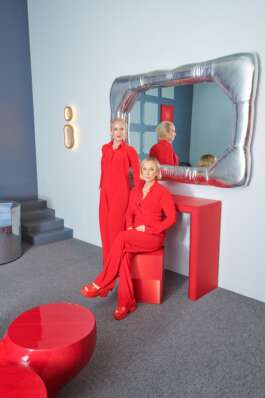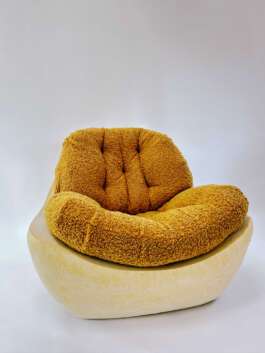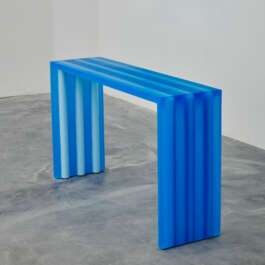



© Matthew Gordon
COLLECTIBLE In-Depth
Tuleste Factory
August 2024
This series, COLLECTIBLE In-Depth, unveils the backstage of contemporary creation. Tackling various topics from personal designer processes to the position of collectible design on the global design market, COLLECTIBLE In-Depth offers different views to suit all tastes. Today we speak with Satu & Celeste Greenberg from Tuleste Factory.
C: Can you talk about the designers you present at COLLECTIBLE this year, what makes their practice unique?
Satu & Celeste Greenberg: This year we will be presenting 8 designers who all use color and lavish, innovative materials to create sensory delight in everything they touch...
Alexandre Ligios
In Alexandre Ligios' quest to create spaces that fully embody presence and connection, he's drawn from his dreams and travels, whether spiritual or physical. Alexandre likes to think that we are all linked by a common desire: to be fully fulfilled in the present moment, here and now. In this mindset, he has chosen every line and material to create warm and contemporary spaces that reflect him and invite authenticity.
Dean & Dahl
Since the early twentieth century, couples like Charles and Ray Eames have shown that the union of two different designers often produces stronger design. Dean & Dahl continues this tradition by uniting the unique talents of Gabriel and Brooke. Gabriel was mentored by Jamie Drake and Vicente Wolfe, two of the design world’s top talents, and holds advanced degrees in both interior and industrial design. In contrast, Brooke specializes in counseling and human behavior. She is focused on how people interact with and are influenced by the spaces they live in. Together, Gabriel and Brooke create interiors that are beautiful but also improve the lives of the people who interact with them.
Facture by Quincy Ellis
Facture is a contemporary design studio located in Brooklyn, NY. Founded by designer Quincy Ellis, the studio creates dynamic pieces from molded resin by manipulating the elements of light, color and transparency. This exploration is central to all of Facture's work, with each design featuring unique colors, shades and opacities. The final product is a body of work that achieves new dimensions in the medium of resin, consisting of objects whose compositions and meaning change in response to the environments in which they are placed.
Ian Alistair Cochran
Ian Alistair Cochran is a designer who is excited by unconventional materials and the relationship that emerges in working with them. He makes contemporary art furniture using resin, fiberglass, composites, and continues to explore other materials not typically used in the design world.
Miranda Makaroff
Miranda Makaroff, born in Spain in 1984 to an Argentine father and a Spanish mother, was surrounded by a creatively vibrant environment from a young age. This nurturing atmosphere allowed her the freedom to explore various artistic mediums, leading her to develop a unique artistic language that integrates different art forms seamlessly. As a painter, sculptor, designer, and actress, Makaroff’s diverse interests shape her creative expression. Celebrating the essence of womanhood, Makaroff's art explores a visual universe free from constraints, characterized by vibrant colors and a touch of whimsical humor. Her work reflects a diverse palette of influences, inviting viewers to immerse themselves in a world of creativity and imagination.
Timbur by Ezra Ardolino
Timbur is an experienced digital fabrication studio that explores the intersection of design, materiality, and robotics as a source for re-imagining the natural world. Founded in 2009 by architect Ezra Ardolino, Timbur has developed distinctive projects for some of the world’s leading architects, designers, artists and brands. Stack and Bark are the result of Timbur’s foray into product design, pulling from their deep roots in digital fabrication and robotics engineering to create unique objects that blur the line between hi-tech and handcrafted.
C: How do you navigate the balance between embracing technological advancements in your design process while preserving traditional craftsmanship?
S&C G: Technological advancements provide new avenues to explore and expand upon ideas. Tools like AI enhancements and 3D modeling open up mind-expanding possibilities that can then be realized through the unique skills of the artist.
Balancing the embrace of technological advancements with the preservation of traditional craftsmanship involves merging the strengths of both approaches. We view technology as a means to amplify, not replace, the core of craftsmanship. The tactile understanding, attention to detail, and the irreplaceable human touch that craftsmanship offers remain essential. For instance, digital tools can refine a design, but it’s the handcrafting that ultimately brings it to life, ensuring the final product retains its authenticity and deep connection to history.
C: What tips would you give to a collector who wishes to start collecting contemporary design?
S&C G: Like anything creative, we believe strongly in a combination of educating yourself and following your passion. Attend design fairs such as Collectible, visit galleries, read valued publications, etc. Understanding use of materials and the narratives behind contemporary works will help you make informed decisions.
Once you have a grasp of the above knowledge, start collecting works that resonate with your personality. Whether it’s a particular style, material, or designer, your collection should reflect your tastes and interests. Passionate collecting often leads to a more cohesive and meaningful collection.
Embedded within this process is a focus on quality and craftsmanship, essential elements of any collection. Pay close attention to the materials, construction, and finishing of each piece, as these factors are paramount in preserving value over time.
C: What strategies do you employ to foster a dialogue between emerging designers and established collectors within your gallery’s ecosystem?
S&C G: Through these initiatives, we aim to bridge the gap between emerging designers and established collectors, nurturing a dynamic dialogue that benefits both parties and enriches our gallery's ecosystem.
It is essential to inform collectors and our interior design clients about the distinct skill sets of these emerging artists, sparking their enthusiasm for exploring and uncovering fresh talent.
C: In what way is public design an inspirational pathway for collectible design?
S&C G: Public design serves as an inspirational pathway for collectible design by offering a platform for innovative ideas and creative expressions to be showcased on a larger scale. Public design projects, such as installations, public art displays, and urban interventions, enable designers to experiment with unconventional materials, techniques, and concepts, sparking new trends and pushing boundaries in the design world. Oftentimes this public platform allows artists to produce on a much larger scale, manifesting a stronger impact.
By engaging with public design projects, artists gain exposure to diverse audiences and contexts, allowing them to test their ideas in real-world settings and receive feedback from a broader range of perspectives. This cross-pollination of ideas between public and collectible design not only fuels creativity but also encourages designers to think beyond traditional boundaries and explore new possibilities in their work.
C: What strategies do you employ to foster a dialogue between emerging designers and established collectors within your gallery’s ecosystem?
S&C G: Through these initiatives, we aim to bridge the gap between emerging designers and established collectors, nurturing a dynamic dialogue that benefits both parties and enriches our gallery's ecosystem.
It is essential to inform collectors and our interior design clients about the distinct skill sets of these emerging artists, sparking their enthusiasm for exploring and uncovering fresh talent.

© Dean & Dahl

© Matthew Gordon

© Matthew Gordon
COLLECTIBLE In-Depth
Tuleste Factory
August 2024
This series, COLLECTIBLE In-Depth, unveils the backstage of contemporary creation. Tackling various topics from personal designer processes to the position of collectible design on the global design market, COLLECTIBLE In-Depth offers different views to suit all tastes. Today we speak with Satu & Celeste Greenberg from Tuleste Factory.
C: Can you talk about the designers you present at COLLECTIBLE this year, what makes their practice unique?
Satu & Celeste Greenberg: This year we will be presenting 8 designers who all use color and lavish, innovative materials to create sensory delight in everything they touch...
Alexandre Ligios
In Alexandre Ligios' quest to create spaces that fully embody presence and connection, he's drawn from his dreams and travels, whether spiritual or physical. Alexandre likes to think that we are all linked by a common desire: to be fully fulfilled in the present moment, here and now. In this mindset, he has chosen every line and material to create warm and contemporary spaces that reflect him and invite authenticity.
Dean & Dahl
Since the early twentieth century, couples like Charles and Ray Eames have shown that the union of two different designers often produces stronger design. Dean & Dahl continues this tradition by uniting the unique talents of Gabriel and Brooke. Gabriel was mentored by Jamie Drake and Vicente Wolfe, two of the design world’s top talents, and holds advanced degrees in both interior and industrial design. In contrast, Brooke specializes in counseling and human behavior. She is focused on how people interact with and are influenced by the spaces they live in. Together, Gabriel and Brooke create interiors that are beautiful but also improve the lives of the people who interact with them.
Facture by Quincy Ellis
Facture is a contemporary design studio located in Brooklyn, NY. Founded by designer Quincy Ellis, the studio creates dynamic pieces from molded resin by manipulating the elements of light, color and transparency. This exploration is central to all of Facture's work, with each design featuring unique colors, shades and opacities. The final product is a body of work that achieves new dimensions in the medium of resin, consisting of objects whose compositions and meaning change in response to the environments in which they are placed.
Ian Alistair Cochran
Ian Alistair Cochran is a designer who is excited by unconventional materials and the relationship that emerges in working with them. He makes contemporary art furniture using resin, fiberglass, composites, and continues to explore other materials not typically used in the design world.
Miranda Makaroff
Miranda Makaroff, born in Spain in 1984 to an Argentine father and a Spanish mother, was surrounded by a creatively vibrant environment from a young age. This nurturing atmosphere allowed her the freedom to explore various artistic mediums, leading her to develop a unique artistic language that integrates different art forms seamlessly. As a painter, sculptor, designer, and actress, Makaroff’s diverse interests shape her creative expression. Celebrating the essence of womanhood, Makaroff's art explores a visual universe free from constraints, characterized by vibrant colors and a touch of whimsical humor. Her work reflects a diverse palette of influences, inviting viewers to immerse themselves in a world of creativity and imagination.
Timbur by Ezra Ardolino
Timbur is an experienced digital fabrication studio that explores the intersection of design, materiality, and robotics as a source for re-imagining the natural world. Founded in 2009 by architect Ezra Ardolino, Timbur has developed distinctive projects for some of the world’s leading architects, designers, artists and brands. Stack and Bark are the result of Timbur’s foray into product design, pulling from their deep roots in digital fabrication and robotics engineering to create unique objects that blur the line between hi-tech and handcrafted.
C: How do you navigate the balance between embracing technological advancements in your design process while preserving traditional craftsmanship?
S&C G: Technological advancements provide new avenues to explore and expand upon ideas. Tools like AI enhancements and 3D modeling open up mind-expanding possibilities that can then be realized through the unique skills of the artist.
Balancing the embrace of technological advancements with the preservation of traditional craftsmanship involves merging the strengths of both approaches. We view technology as a means to amplify, not replace, the core of craftsmanship. The tactile understanding, attention to detail, and the irreplaceable human touch that craftsmanship offers remain essential. For instance, digital tools can refine a design, but it’s the handcrafting that ultimately brings it to life, ensuring the final product retains its authenticity and deep connection to history.
C: What tips would you give to a collector who wishes to start collecting contemporary design?
S&C G: Like anything creative, we believe strongly in a combination of educating yourself and following your passion. Attend design fairs such as Collectible, visit galleries, read valued publications, etc. Understanding use of materials and the narratives behind contemporary works will help you make informed decisions.
Once you have a grasp of the above knowledge, start collecting works that resonate with your personality. Whether it’s a particular style, material, or designer, your collection should reflect your tastes and interests. Passionate collecting often leads to a more cohesive and meaningful collection.
Embedded within this process is a focus on quality and craftsmanship, essential elements of any collection. Pay close attention to the materials, construction, and finishing of each piece, as these factors are paramount in preserving value over time.
C: What strategies do you employ to foster a dialogue between emerging designers and established collectors within your gallery’s ecosystem?
S&C G: Through these initiatives, we aim to bridge the gap between emerging designers and established collectors, nurturing a dynamic dialogue that benefits both parties and enriches our gallery's ecosystem.
It is essential to inform collectors and our interior design clients about the distinct skill sets of these emerging artists, sparking their enthusiasm for exploring and uncovering fresh talent.
C: In what way is public design an inspirational pathway for collectible design?
S&C G: Public design serves as an inspirational pathway for collectible design by offering a platform for innovative ideas and creative expressions to be showcased on a larger scale. Public design projects, such as installations, public art displays, and urban interventions, enable designers to experiment with unconventional materials, techniques, and concepts, sparking new trends and pushing boundaries in the design world. Oftentimes this public platform allows artists to produce on a much larger scale, manifesting a stronger impact.
By engaging with public design projects, artists gain exposure to diverse audiences and contexts, allowing them to test their ideas in real-world settings and receive feedback from a broader range of perspectives. This cross-pollination of ideas between public and collectible design not only fuels creativity but also encourages designers to think beyond traditional boundaries and explore new possibilities in their work.
C: What strategies do you employ to foster a dialogue between emerging designers and established collectors within your gallery’s ecosystem?
S&C G: Through these initiatives, we aim to bridge the gap between emerging designers and established collectors, nurturing a dynamic dialogue that benefits both parties and enriches our gallery's ecosystem.
It is essential to inform collectors and our interior design clients about the distinct skill sets of these emerging artists, sparking their enthusiasm for exploring and uncovering fresh talent.

© Dean & Dahl

© Matthew Gordon
Contact
info@collectible.design
VIP PORTAL
EXHIBITOR PORTAL
PRIVACY POLICY
© 2025 Collectible
Contact
info@collectible.design
VIP PORTAL
EXHIBITOR PORTAL
PRIVACY POLICY
© 2025 Collectible